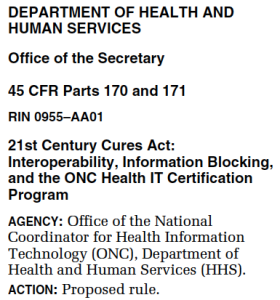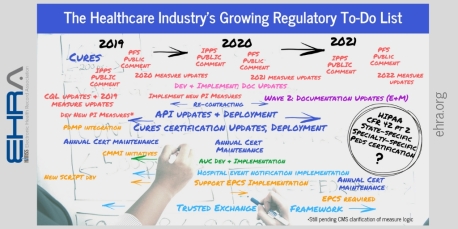 We had been waiting for the Office of the National Coordinator for Health IT to release the proposed rule fulfilling its Cures Act obligation for quite a while. Encompassing important issues like expanded interoperability, defining what is and isn’t information blocking, as well as proposing updated certification requirements, this is an important rule to get right.
We had been waiting for the Office of the National Coordinator for Health IT to release the proposed rule fulfilling its Cures Act obligation for quite a while. Encompassing important issues like expanded interoperability, defining what is and isn’t information blocking, as well as proposing updated certification requirements, this is an important rule to get right.
Since the release, there have been lots of discussions—public and private, online and off—about intended and potentially unintended impacts of the language in the proposal. With so much to consider and analyze, we appreciate that the request from EHRA and other groups to give us a full three months to draft our comments on the rule was approved.
The tremendously broad reach of the proposed rule goes far beyond Congressional intent.
The EHR Association’s comments are now going through final rounds of review by our executive committee (and the seven workgroups and task forces that contributed their expertise). We worked throughout the drafting of the 21st Century Cures Act with Congress and are supportive of its goal to remove obstacles to information exchange, but we have found that the tremendously broad reach of the proposed rule goes far beyond Congressional intent. In particular, we have significant concerns regarding timelines, ambiguous language, disincentives for innovation, and definitions related to information blocking.
Negative Impacts on Innovation
As written, the proposed rule would discourage innovation by imposing limitations on profit as well as compulsory licensing terms for new intellectual property, created through extensive investment in development. Essentially, it requires EHR developers and others to share their intellectual property with anyone who asks under “Fair, Reasonable and Non-Discriminatory,” or FRAND, terms.
A compulsory licensing model would have a chilling effect on innovation, by removing incentives for new or established companies to invest in emerging technologies or any significant effort to update existing ones.
Normally, companies choose when and to whom they contribute their technology, such as through the standards development process, but a compulsory licensing model means that anyone could ask for our intellectual property, and for a “reasonable” price-capped fee they’d be able to layer their own work over ours or otherwise repurpose it. Clearly this would have a chilling effect on innovation, by removing incentives for new or established companies to invest in emerging technologies or any significant effort to update existing ones.
Additionally, the complexities woven throughout the rule, such as requiring the maintenance of full documentation to justify cost models, would create a new regulatory burden that is likely to hinder innovation from both already-certified developers and potential new entrants to the health IT space.
We are also disappointed that the proposed rule seems to imply that established EHR developers are incapable of innovation. That is an inaccurate characterization that trivializes the work that companies in our Association do every day to improve clinician experience and bring new emerging technologies to the market.
We believe that the proposed rule risks disrupting natural market forces and creating an industry environment where companies are forced to do little more than focus on regulatory compliance, defense against information blocking claims, API creation, and pursuit of patents. We urge ONC to think about the implications if any vendor(s) ultimately decides the regulatory burdens that could be imposed by this rule outweigh the opportunity that remains.
Overly Broad Definitions Related to Information Blocking
We recognize and appreciate the extensive, thoughtful effort on the part of ONC and Office of the Inspector General (OIG) to define the required exceptions to the information blocking sections of the 21st Century Cures Act. While the proposed rule took some time to be propagated, we believe there is great value in the work that the agencies did to engage multiple stakeholders (including the Association) in gathering practical and measurable input.
That said, we believe ONC has gone well beyond what was intended, such as in the definitions of “interoperability elements” and “electronic health information.” Both are written so broadly as to pull in technologies and stakeholders well outside of what is reasonable, and we strongly encourage that those definitions be revisited to narrow them significantly.
In our comments, we point out that several components of the Exceptions section as proposed do not seem enforceable, either because of ambiguity, difficulty tracking, or the number of resources available at ONC and OIG.
Unrealistic Timeline
To better aid ONC as it considers changes to the proposed rule, our comments will include data from a survey of EHRA member companies on projected development that would be required to comply with product changes proposed in the rule. We’re finding that while some updated functionality or proposals may be straightforward to achieve in a short timeline, the proposed 24-month timeline for development, testing, training and implementation across all our clients is not feasible for the more challenging proposals, which require complex coding and implementation processes.

Regulations affecting EHR developers and healthcare providers.
The short timeframe also raises other questions, such as, how will potential conflicts between the timelines in the proposed rule and requirements of other CMS and ONC programs be resolved? Developers and providers already juggle dozens of other regulations and reporting requirements, so it will be important to identify where and how measures in this proposal intersect with timeframes for existing rules or programs.
EHRA’s comments will suggest a focused scope that is achievable and manageable for our clients and provide a solid path to build upon, highlighting topics that we believe matter most.
Ambiguous Language
The proposed rule’s use of ambiguous language presents challenges to planning and compliance for both developers and providers. While the language was well-crafted in many instances, some sections of the proposed rule offer room for interpretation, with words and phrases like “reasonable” and “as soon as possible.” These vagaries inherently conflict with ONC’s intent to propagate a rule that is clear, predictable and administrable.
Ambiguous language inherently conflicts with ONC’s intent to propagate a rule that is clear, predictable and administrable.
For example, the phrase “near real-time” requires clarification. Timely execution depends on a number of factors which may be beyond the EHR developer’s control, such as capacity of a client’s hardware and the volume of data. While our interpretation of the phrase “near real-time” includes flexibility to account for unpredictable factors like these, we are concerned that our expectations may differ from the federal government’s.
Vague or ambiguous regulatory language can pose tremendous risk to affected stakeholders, especially where maximum penalties are as high as $1 million per infraction. Our comments will request that additional clarifications and examples be made before finalization of the rule, possibly through issuance of an Interim Final Rule rather than a Final Rule this fall, to allow continuation of the clarification and feedback process.
We will also suggest that some type of mechanism be launched to the industry through which any party can submit questions about specific interpretations of the rule for response in a reasonable amount of time, such as whether a certain time frame does, indeed, qualify as, “as soon as possible,” or whether a certain approach to cost recovery is “reasonable.”
Once submitted, our final comments will be posted on the EHRA website. We appreciate ONC’s continuing efforts to move the nation’s healthcare system toward improved patient care. We expect ONC to hold developers to high standards and implementation timelines, and we also hope that the agency will work with the development community to finalize requirements that are achievable.

7 Comments